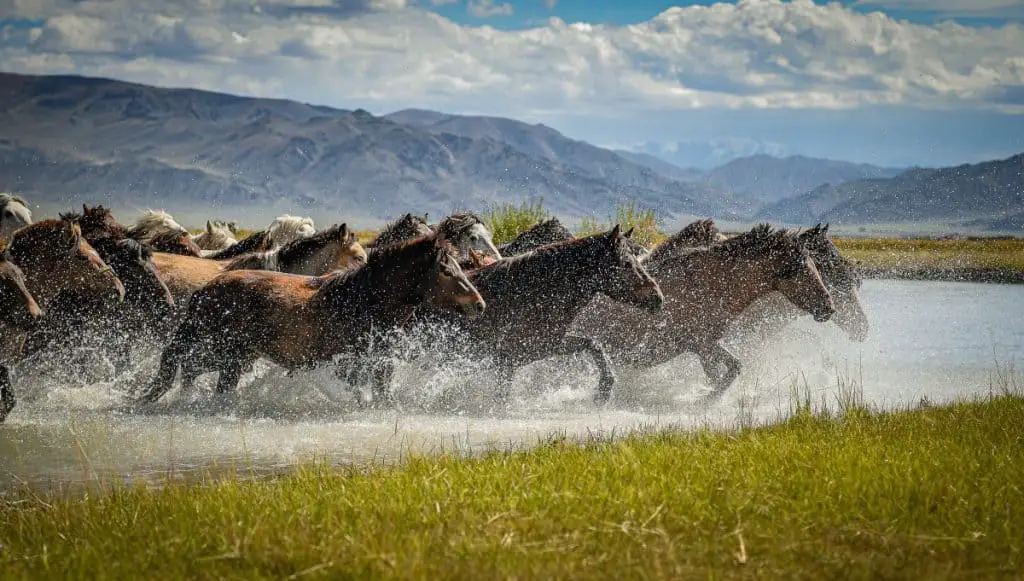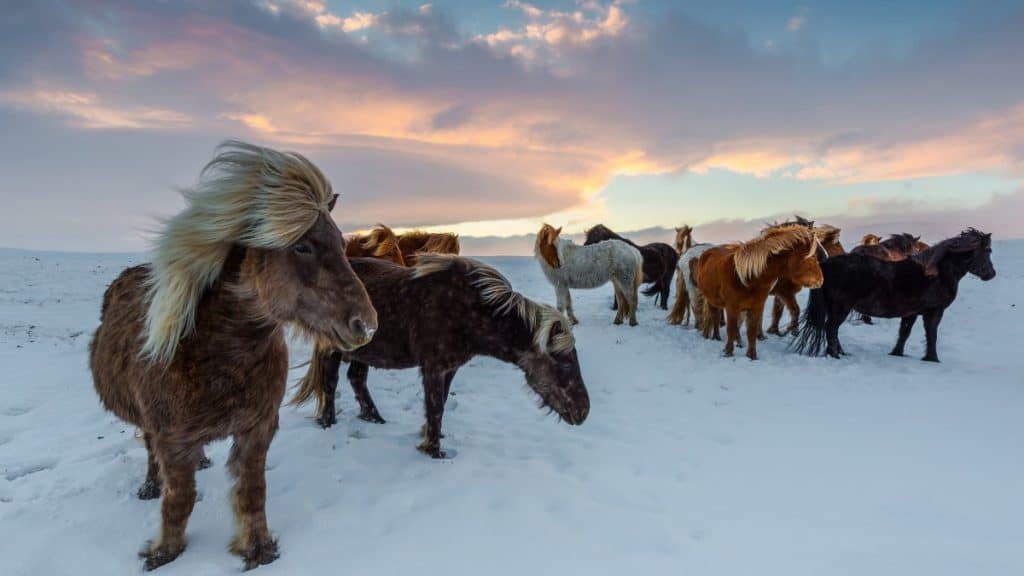Skip To Section
Many names come up when someone asks – “What is the oldest breed of horse”? There is, however, general consensus that the oldest identifiable horse and pony breeds include the Icelandic and Norwegian Fjord horses from Northern Europe, the Caspian and Arabian horses from the Middle East, the Akhal-Teke from Turkmenistan, and the Mongolian horse from Asia.
What Is The Oldest Breed Of Horse?
The oldest breed known to man is the Icelandic horse. They are known to be at least 10,000 years old and have ties with Mongolian horses and Viking ponies. Their history runs deep within the equine world.
Horse Breeds In Order Of Antiquity
The six oldest horse breeds known to man include:
- Icelandic (from Iceland and Scandina at least via) – at least 10,000 years old
- Caspian (from Iran) – at least 5,400 years old
- Arabian (from the Middle East) – at least 4,500 years old
- Mongolian (from Mongolia and Central Asia) – at least 4,000 years old
- Akhal-Teke (from Turkmenistan) – at least 3,000 years old
- Norwejian Fjord (from Norway) – 2,000 years old
More details about each of these breeds follow. We will not focus on physical characteristics quite as much as the history and relevance of each of these species.
1. The Icelandic Horse
The Icelandic horse breed is probably at least 10,000 years old, developed with influence from both Mongolian horses (as ancestors). They developed further in the 9th and 10th centuries from ponies of Viking settlers to Iceland. Along the way, they are thought to have picked up a genetic mutation from Medieval England, which created an ability in them to amble.
Suited to the rough terrain and long-distance riding that the Norsemen were used to, their comfortable gait made them a precious commodity – interbreeding was banned by law as early as the 10th century. The breeds seen today, popular for their gait and ability to endure, are virtually unchanged over a thousand plus years.
Click here to read more about this beautiful breed.

2. The Caspian Horse
The Caspian horse has been around since the ancient Mesopotamian civilization. Their descendants settled in Northern Iran, where they are still found in some areas.
They are smaller than the Arabian, for example, but have the athletic build that makes them popular for cross-breeding and participation in equestrian competitions where intelligence and athleticism are both required. Their gentle disposition makes them popular as family pets.
The oldest known skeleton of a Caspian horse was dated to 3,400 BC – due to their age and proximity, many believe them to be the ancestors of Arabian horses.
The Caspian Horse is an ancient breed that was almost extinct before being rediscovered in 1965. Louise Firouz (an American horse breeder) was largely responsible for the breed’s resurgence and protection, but she has since passed away. The Caspian Horse is currently listed as an endangered species.
Find out more about this breed here.

3. The Arabian
The Arabian is possibly the most recognizable horse breed in the world, employing a premier position among horses raced, for starters.
They developed in the Middle East and were domesticated and nurtured by the Bedouins roughly 4,500 years back. At the time, they were used for transport and as speed horses during raids.
Tall and majestic, carrying their tails high, Arabian horses and mares have been interbred by horse purists and enthusiasts all over the world. Their offspring are known to be refined, with a strong bone structure, bursts of speed, and great stamina.
Find out more about this amazing breed here.

4. The Mongolian Horse
The Mongolian horse may be one of the oldest pure species found in the world today. Bones have dated them back to at least 4,000 years, but they are likely much older in origin. An ancient warhorse, the Mongols still revere the breed, using them in everyday life for sport, transport, and even for their milk.
Mongolian horses, due to their history and also the propensity to roam the vast plains of Central Asia, are thought to have influenced many other breeds – including Scandinavian, British and Japanese species and the Akhal-Teke.
Find out more about the Mongolian breed here.

5. The Akhal-Teke
The Akhal-Teke, easily distinguished by their metallic shiny coats, endurance and gait, share common ancestors with the Arabian horse and were also influenced by Mongolian breeds.
The father of several modern horse breeds such as the Thoroughbreds, the Akhal-Teke are great show horses. They are also capable of traveling great distances without food and water.
Find out more about the Akhal-Teke.

6. The Norwegian Fjord Horse
Bred on the mountainsides and terrains of Norway, these sturdy horses were known for their sense of balance and the capability of traveling over both land and sea. This characteristic made them favorite rides of Viking cavalrymen, but they were equally adept for farm work as draft horses.
Their ancestors include Mongolian horses, but in general, they have changed little over the past 2,000 years. Their long history of domestication and smooth, balanced gait make them family favorites in modern times.
Find out more facts and information on the Norwegian Fjord horse here.

Why Some Horse Breeds Survived For Thousands Of Years
One of the criteria used in the search for the oldest horse is whether or not clear genetic traits can be identified across generations. Another may be to search for a breed still in existence. The descendants of some of the breeds discussed below are around even today. Others have survived through successor breeds. Still, others have been “rediscovered”.
In any case, the history of man’s equine companions is as much a story of human civilization and endurance as it is of the horse species themselves. Domesticated horses have been integral to the growth of communities. They helped armies fight, explorers seek new horizons, farmers till their lands … the list goes on. We would not be here today without the help of horses in the world.
Well-Known Horse Breeds Follow Dominant Civilizations
It makes sense that the oldest breeds of horses that can be identified as stable populations were co-located with some of the oldest civilizations, who were also keen on expanding their reach beyond their original boundaries through conquest, exploration, and/or trade. The genes of the most useful, dominant breeds thus spread across zones of influence.
Historical evidence shows that humans began to come in regular contact with wild horses after the end of the last Ice Age. probably as early as 10,000 BC. The emergence of the domestic breed of horses likely began 4,000 and 6,000 years ago. Early breeds of horses that were deemed useful included those suited for drudgery (e.g., draft horses) or for warfare. Nurturing and breeding created distinguishable species.
The World’s Last Remaining Wild Horse
We have talked about the Mongolian Horse above. However, there is another, rare species among all the horse breeds in the world. They are found on the Mongolian steppes of the Gobi Desert. These are the Przewalski horse – the last remaining wild horses in the world.
Short and stocky, these horses once roamed the steppes of East and Central Asia across a wide range in ancient times. Over time, they have died out in the wild almost everywhere – except for populations that have been reintroduced in China, Mongolia, and Kazakhstan.
The Final Word
The interesting point to note about the discussion of the oldest horse breeds in the world may be simply this – many of the breeds are around today, through genetic traits that have not only been passed down across generations but refined through animal husbandry and cross-breeding.
